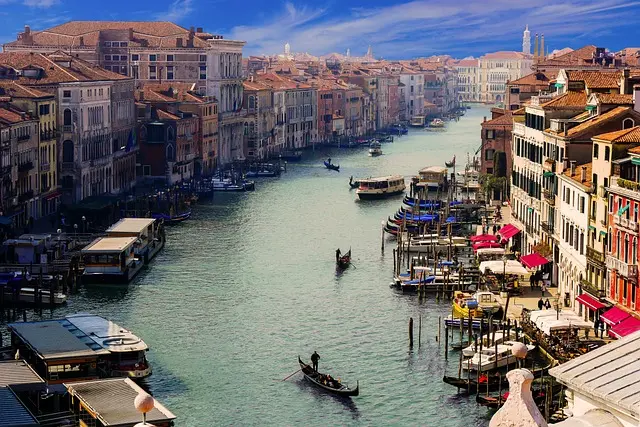
First Stop: The Grand Canal
Venice has always been inseparably tied to water. The Grand Canal, spanning 4 kilometers, gracefully cuts through the city, connecting its beautiful corners in the shape of an upside-down “S”. More than 100 canals are interconnected, filled with water buses, gondolas, and yachts.
When you arrive at the Santa Lucia Railway Station, don’t forget to buy a water bus pass. A 30-minute ride will take you to St. Mark’s Square, where you can slowly take in the stunning sights of the Grand Canal.
The most beautiful time to visit the Grand Canal is at sunset. The water shimmers under the fading sunlight, and the Byzantine architecture along the banks is bathed in a golden glow. The vastness of the scene is simply breathtaking.
Second Stop: Italian-Style Architecture
The landmarks on land are very close to each other and just a few minutes’ walk apart.
If you want to experience the epitome of luxurious European architecture, the Basilica di San Marco is the place to go. Once the largest church in medieval Europe, it is a classic example of Venetian architectural art. With its Byzantine style, it blends the essence of both Eastern and Western architectural elements. The church features five Romanesque arches on the front, topped with Eastern-style and Gothic spires and a variety of marble sculptures and bas-reliefs. Its massive dome and unique mosaics are its most distinctive features.
Afternoon is the best time to visit Venice. If you’re lucky enough to reach the top of the tower at sunset, you will be treated to a golden view of the entire city of Venice bathed in the warm light of the setting sun.
At the corner of St. Mark’s Square stands another famous landmark, the Bridge of Sighs. Historically, after prisoners were interrogated in the Doge’s Palace, they would cross the Bridge of Sighs, looking out one last time through its stone windows at the world outside. The sight often prompted a final sigh, and that’s how the bridge got its name.
Third Stop: The Colorful Island
The colorful island is located about 10 kilometers from the main island of Venice, and you can reach it by taking the number 12 water bus, which takes about 45 minutes one way.
On this island, the houses are painted in vibrant colors, with each house uniquely colored, never repeating the same shade as the neighboring one. The entire island, with its random, colorful patches, creates a fascinating harmony.
Walking amidst these rainbow-colored buildings feels like stepping into a fairy-tale world, as if God accidentally knocked over a paint palette, leaving behind a magical place of whimsy.
Summary
Venice is not just beautiful, but also peaceful. Some say that the city has gradually lost its purity due to commercial influences, but that’s not entirely true.
At sunset, find a quiet spot to sit and watch as the crowds of tourists slowly disperse. The sea breeze blows gently, and the salty smell of the sea fills the air. Watching the seagulls flutter nearby, you realize that this is the true beauty of life – serene and stunning. It’s truly special.
